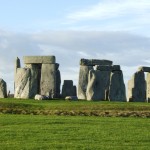Stonehenge
A gigantic construction of Stonehenge is “a stone enigma in the very center of Europe,” as one of the researchers Doctor Wilmore Trever once called this amazing monument. This is an ancient construction located in England. Now archeologists believe that this archeological monument was built in three stages between 3500 and 1100 B.C. Stonehenge I consisted of a circular bank and ditch enclosure with two halls and may have been a cemetery. Within the outer edge of the enclosed area is a circle of 56 pits, known as the Aubrey holes after John Aubrey, the 17th-century antiquarian who was thought to have first identified them. North-east of the entrance into the circle the huge Heelstone stood, seven meters high. When Stonehenge II was built an earthen alley between the Heelstone and the entry was paved. Two circles were erected of 80 huge bluestones that were, probably, brought from a place in Southern Wales, 320 kilometers away. At the final stage of the construction megaliths were replaced. The bluestones were replaced by a colonnade of 30 trilithons, each one of which consisted of two vertical stones and a horizontal plate that rested on them. Inside the circle there was a horseshoe of five separately standing trilithons.
As a whole, Stonehenge is a construction of 82 five-tone megaliths, 30 25-ton stone blocks and 5 huge so called trilithons that weigh up to 50 tons. The stone blocks put together form arches that once were flawless indicators of cardinal directions. Until recent times the scientists supposed that the monument was constructed in 3100 B.C. by tribes who lived on the British Isles for observation of the Sun and the Moon. But the latest data of modern science make us reconsider many conclusions of the researchers. Back in the 1920s, a famous geologist H. Thomas determined that the stones for the construction of the complex were delivered from quarries that are located more than 300 kilometers away from the construction site. It is needless to say that transportation of giant stone blocks required tremendous efforts. In the end of 1994, professor of the Wales University David Bowen calculated Stonehenge’s age using the newest method. It turned out to be 140,000 years. So why did the ancient people need to exert such enormous efforts for cutting out, undertaking the most difficult transporting and processing of solid blocks of stones and setting them in an incredibly exact configuration in strict order? There is no answer to this question yet.
A famous astronomer Fred Hoyle, after studying all geometric peculiarities of Stonehenge, determined that the makers of this construction knew exact orbital period of the Moon and duration of solar year. According to other researchers’ conclusions, the pits inside the circle exactly signify the trajectory of the celestial pole 12-30 thousand years ago! In 1998 scientists-astronomers recreated on a computer the original appearance of Stonehenge and conducted different surveys. Their conclusions shocked many people. It turned out that this ancient monolith is not only a solar and lunar calendar as supposed before, but is also the exact model of the solar system in cross section. According to this model, the solar system consists not of nine but of twelve planets, two of which are beyond the orbit of Pluto’s (the last of all the known nine planets today) and one more is between the orbits of Mars and Jupiter where right now there’s an asteroid belt. In principle, this model confirms suppositions of modern astronomic science and is in full accordance with the ideas of many ancient peoples, who also believed that the number of planets in our solar system is twelve.
Unusually high seismic strength is a characteristic of all ancient megaliths. Research showed that at their construction special platforms were used that softened or fully reduced shocks of earthquake. On these platforms the majority of all the ancient constructions are built. Beside that, such fundamentals give almost no way to shrinkage of soil, which inevitably takes place with today’s construction.
The scientists don’t know yet who and for what purpose erected a grandiose astronomic observatory in the heart of England. But after thoroughly conducted surveys it became clear that to ascribe the erection of this huge “megalith” to the ancient tribes of druids, who lived on the territory of Britain at those times, is just not wise. The only thing is clear: whoever the ancient builders were they possessed great knowledge of astronomy, mathematics, geology and architecture. And taken into consideration that grandiose monuments and constructions at prehistoric time were erected all over the world, a conclusion can be drawn that we, today’s human beings, know almost nothing about our own history.
And while the scientists are studying this ancient monument, Stonehenge continues to live its own life in people’s folklore. As a local legend has it, gigantic bluestones possess a power to heal; they appeared on this earth because of magician Merlin, a sorcerer in King Arthur’s court, who transferred them over from Ireland. The origin of the huge Heelstone has something to do with another legend. They say that once the devil saw a monk hiding among the stones. Before the unlucky guy had time to escape the devil threw a huge boulder at him, which pressed down his heel. For a long time Stonehenge associated with the priestly cult of ancient Druids, although the specialists believe it is not true.

